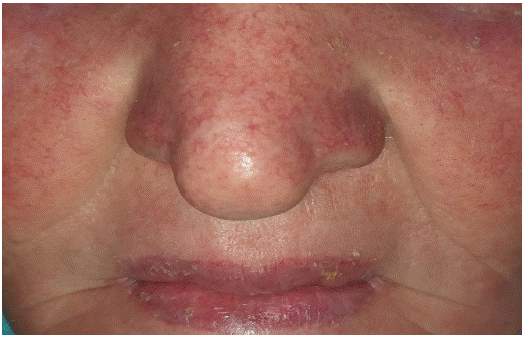Abstract
The most common ocular manifestations of rosacea include chronic blepharitis, conjunctival fibrosis, punctate keratitis, corneal ulceration, peripheral neovascularization. Cicatricial ectropion is rarely reported as a complication of this pathology, physiopathologie seems to be related to a type IV hypersensitivity reaction in the conjunctival tissue.
We report the case of a patient with bilateral ectropion, secondary to ocular rosacea, with alteration of the break-up time (5 seconds), an eversion of lacrimal punctum which is fibrotic and a crust on the free margin of the eyelid, we also found conjunctival fibrosis, punctate epithelial keratitis.
Introduction
Rosacea is a common chronic inflammatory dermatosis affecting approximately 10% of the population [1]. Rosacea affects the axial facial skin, more specifically, cheeks, chin, nose, and central forehead. The manifestations include transient or persistent erythema, telangiectasias, papules, pustules, and phymatous changes [2].
Ocular manifestations of rosacea include chronic blepharitis, chronic conjunctivitis, conjunctival fibrosis, punctate epithelial and interstitial keratitis, corneal ulceration, peripheral neovascularization, and peripheral ulcerative keratitis [3].
We report the case of a patient with bilateral ectropion, secondary to ocular rosacea. To our knowledge, this ocular complication is little described in the literature.
Case Report
A 68 years old woman was referred to our structure for the management of bilateral ectropion. She relates this manifestation 18 years ago which progressed gradually. Previously, the patient had been followed for 30 years for rosacea with multiple periods of exacerbation per year, with poor compliance with treatment.
In her ocular examination, the patient’s best-corrected visual acuity was 3/10 OD, 4/10 OG, with a normal intra ocular pressure. Her ocular motility and pupil reflex were normal in both eyes. The external examination revealed cutaneous rosacea with rhinophyma and cicatricial ectropion in both eyes. The cicatricial ectropion was characterized by lower eyelid eversion. Biomicroscopy revealed an augmented lacrimal river, eversion of lacrimal punctum which is fibrotic and a crust on the free margin of the eyelid. We found conjunctival fibrosis, punctate epithelial keratitis and alteration of the break-up time (5 seconds). The rest of the ophthalmological exam revealed a subcapsular cataract without oders anomalies.

Figure 1: Image showing cutaneous rosacea in our patient with rhinophyma.

Figure 2: A/B/C: Right eye D/E/F: Left eye
A/D- Ectropion and crust in the free margin of the eyelid
B/E- Fibrotic lacrimal punctum
C/F-Punctate epithelial keratitis and augmented lacrimal river
We proposed an ocular surface treatment to our patient, by artificial tears drops with high concentration of hyaluronic acids and vitamin A. Also, stabilization of her rosacea by dermatologist, then we proposed the patient for a surgical treatment of her ectropion.
Discussion
Cicatricial ectropion may be caused by brevity of the anterior laemella following a burning of the face, a trauma or excessive skin excision post-blepharoplastye. Also, chronic dermatitis may be responsible of this type of ectropion [4,5]. De Groot et al. affirm that inflammatory conditions of the periorbital skin participate in apparition of cicatricial ectropion [6].This inflammatory state is found in multiple infectious and immunologic diseases such as ichtyosiform erythroderma, xeroderma pigmentosum, toxic epidermal necrolysis, leprosy, epidermolysis bullosa, dermatomyositis [7,8].
Multiples studies have reported association between autoimmune disease and ectropion. In a case report published on 2012, severe chronic blepharitis and scarring ectropion were associated with discoid lupus eryhtematous [9]. Psoriasis arthritis was also found to cause cicatricial ectropion in on other recent reports [10]. But to our knowledge, cicatricial ectropion due to rosacea was the first time described in 2004 by the Chicago medicaluniversity. Our study reinforces this finding and special attention is needed to prevent this complication in ocular rosacea patients.
The main physiopathological pathway seems to be type IV hypersensitivity reaction in the conjunctival tissue which is seen in ocular rosacea [3]. This chronic reaction appears to be responsible for the retraction of tissues which is complicated by cicatricial ectropion. Cruz et al. founded that 2.5%of their 439 patients with paracoccidioido mycosis experienced cicatricial changes that induced eyelid malpositions such as entropion or ectropion which affirms the relationship between chronic conjunctivitis and eyelid malpositions [11].
Conclusion
Cicatricial ectropion is one of the common types of ectropion that has been described. Inflammatory disorders such as rosacea could be one of the causes of this cicatricial eyelid malposition. Optimal treatment of rosacea and all other inflammatory disorders is mandatory to prevent the cicatricial ectropion.
References
- Rainer BM, Kang S, Chien AL. Rosacea: Epidemiology, pathogenesis, and treatment. Dermato-Endocrinology. 2017; 9: e1361574.
- Vieira AC, Mannis MJ. Ocular rosacea: Common and commonly missed. Journal of the American Academy of Dermatology. 2013; 69: S36-S41.
- Ravage ZB, Beck AP, Macsai MS, Ching SST. Ocular Rosacea Can Mimic Trachoma. Cornea. 2004; 23: 630–631.
- Les ectropions M Elbelhadji, H Amrani-H, Z Bounsif, El M By, A Mchachi, A Amraoui Service d’Ophtalmologie adulte, Hôpital 20 Août, CHU IbnRochdcasablanca Université Hassan II Faculté de Médecine et de Pharmacie de Casablanca. 2017.
- Ectropion Omar Ozgur 1, Evan J Kaufman 2 In: Stat Pearls. Treasure Island (FL): StatPearls Publishing; 2020 Jan. 2020 Aug 12.
- DeGroot AC, Poelhuis JWK. Ectropion caused by periocular dermatitis. Journal of the American Academy of Dermatology. 2001; 44: 385–386.
- Thompson K. Ocular morbidity in a sample of 150 treated leprosy patients. Indian J Lepr. 1998; 70: 127-30.
- Blaschke S, Möller R, Hausser I, Anton-Lamprecht I, Paul E. Comèl- Netherton-Syndrom. Hautarzt 1998; 49: 499-504.
- Kopsachilis N, Tsaousis KT, Tourtas T, Tsinopoulos IT. Severe chronic blepharitis and scarring ectropion associated with discoid lupus erythematosus. Clinical and Experimental Optometry. 2012; 96: 124–125.
- Gracitelli CPB, Osaki TH, Valdrighi NY, Viana GAP, Osaki MH. CicatricialEctropion Secondary to Psoriatic Arthritis. Case Reports in Ophthalmological Medicine. 2015; 2015: 1–3.
- Cruz AAV, Zenha F, Silva JT, Martinez R. Eyelid Involvement in Paracoccidioidomycosis. Ophthalmic Plastic & Reconstructive Surgery. 2004; 20: 212–216.
